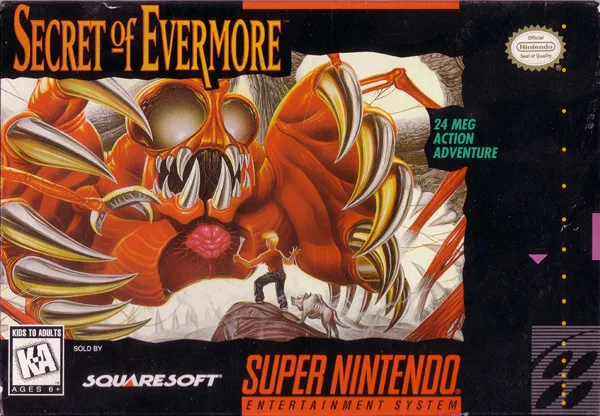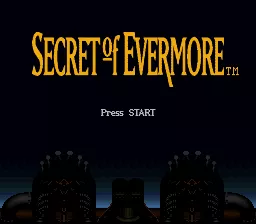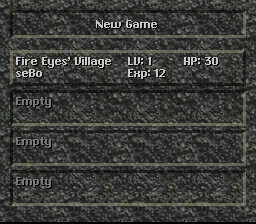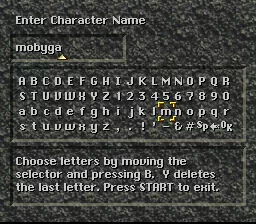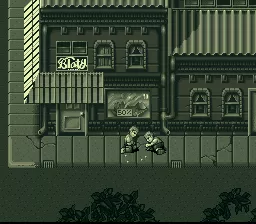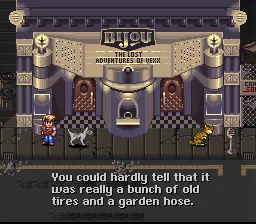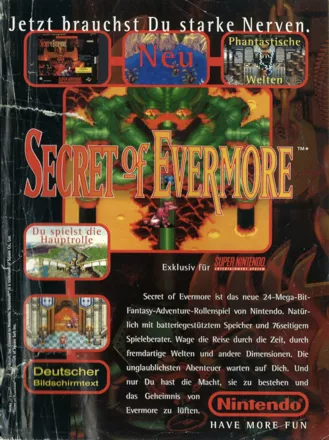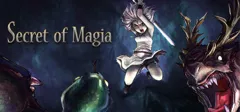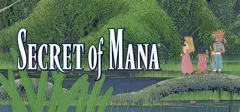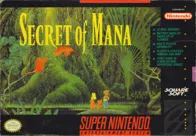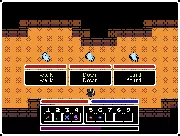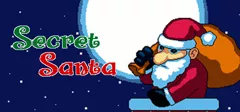Secret of Evermore
Description official descriptions
A boy and his dog live together in the town of Podunk. One day, the boy chases the dog into an old abandoned mansion where a scientist lived thirty years ago. Some of his equipment is still operational, and when the dog chews on it, they are both sent to the strange world of Evermore, and have to figure out how to get back.
Secret of Evermore is an action RPG similar to Secret of Mana, with a few key changes. Multiplayer is out. Rather than three characters, there are just the two. The equivalent of magic is alchemy, where each effect requires several base ingredients which the player gathers as the game advances.
Groups +
Screenshots
Promos
Credits (SNES version)
43 People (42 developers, 1 thanks) · View all
| Executive Producer | |
| Concept Producer | |
| Design Producer | |
| Technical Producer | |
| Associate Producer | |
| Lead Programmer | |
| Programmers | |
| Art Director / Character Concepts | |
| Lead Animator | |
| Animators | |
| Lead Background Artist | |
| Background Artists | |
| 3D Artist | |
| Scenario Scripters | |
| [ full credits ] | |
Reviews
Critics
Average score: 82% (based on 23 ratings)
Players
Average score: 3.9 out of 5 (based on 45 ratings with 3 reviews)
The Good
Welcome to my Secret of Evermore review.
Secret of Evermore is, sort of between a spin-off of the Seiken Densetsu series (itself started as a spin-off of the Final Fantasy series), and a false sequel to Secret of Mana.
This game was developed by the American Squaresoft team, about when Seiken Densetsu 3, the real sequel to Secret of Mana, was going to be released in Japan. For some obscure reason, Square America decided to develop this game instead of translating SD3, in order to provide fans with a sequel. Having been developed by the American team, the game has almost nothing in common with Japanese developed Square games. This is why I consider it a "fake sequel", although this game's mechanics gameplay try to mimic Secret of Mana as much as possible (in some regards, more than other games of the Seiken Densetsu series), it actually has not caught the soul or universe of the Seiken Densetsu series at all.
Nevertheless, for what this game is, I can only say it is very good, and that Square USA did their best to release a very enjoyable game.
First of all the gameplay : It is almost exactly like Secret of Mana, and unlike any other game in the Seiken Densetu series. This is an action-RPG game, and in battle, you can use your weapon with the 'B' button. An energy meter then fills itself to 100% at which point a small noise will play, indicating that you can attack again. You can attack before 100% is reached, but the attack will be very weak, punishing you for not being patient enough. You can also run, which also uses your energy meter. Once a weapon is levelled up, you can charge it by holding the B button, reaching 200% or 300%, and releasing a super attack. You can also cast spells (in this game an alchemy system runs the spells instead of a spirit system like Seiken Densetsu games), and the spells are not affected by the energy meter - you can cast them anytime and as quickly as you want.
The story resolves around a boy and his dog, which gets miraculously transported from the real world to a strange world. You start the story in the prehistoric area, and then an antiquity area, middle-ages area and futuristic area will come.
In this regard, the game plays and feels exactly like Secret of Mana, and the creators were very successful in cloning the gameplay as much as possible. The irony is that this makes this game extremely distant from other Seiken Densetsu sequels (Seiken Densetsu 3, Legend of Mana), which plays more like Beat'em Up games. However, the game added more gameplay features than Secret of Mana, which makes it more interesting to play.
The key to the additional features is your dog, which is able to search various treasure by sniffling. There is many ingredients, items required for alchemy such as water, ethanol or ashes, all over the place, and often at logical place, such as petals near flowers, or ashes near a fireplace. Ingredients are necessary for casting spells, including healing, so hunting for them is interesting and rewarding.
I cannot say how great of an idea it was to have a dog as a companion, rather than other heroes like it is the case in 90% of RPGs. It really sets the mood for the game and change the perspective a lot. In each of the historical areas, you have a different dog, which actually is the same dog which changes of physical appearance, so it is not too boring. In addition to those 4 different dogs, there is the normal dog from the real world but it is never playable.
The graphics in Secret of Evermore are absolutely gorgeous and top-notch for the system. The game was released late in the SNES lifetime, and they made sure to push the system to its limit. The prehistoric area really feels wild, and the middle-ages area feels very dark. The characters and the dog are very realistic. The backgrounds are full of well done shadow effects. The only downside is that the hero is an extremely generic and forgettable guy, but really this isn't much of an issue.
The game itself is not only fun to play, but also is packed up of jokes which is refreshing for Square games, which usually takes themselves very seriously. There is just too many funny things in this game for me to mention them all, but be sure that some humour will be there, and it is for the best. There is also many other references to Final Fantasy games, and to imagined movies that have stupid and funny names.
Although there is not many musical pieces in the game, especially for Squaresoft standards, I should mention that there is still a few very memorable songs in this game, especially the opening song, that will make you want to listen them again. The sound effects (which makes most of the game's sounds) are very well done and realistic.
The game system do not stop with weapons and alchemy formulas I have already mentioned. There is also the summons, which are barely useful but still they deserve a mention, unlike in Secret of Mana summons and spells (alchemy formulas) are separated. Most spells starts being not very useful but becomes powerful as you level them up, just like in other Seiken Densetsu games. There is also a trade system where you can buy some stuff to trade against other stuff to get items that enhance your stats, and there is different currencies for each historic areas.
The bosses in this game are extremely varied, for the most part extremely though and requires a lot of strategy to be defeated. Even the very first boss is extremely challenging and epic.
The artificial intelligence has been greatly improved, your dog do not "get stuck" like you comrades would do in Secret of Mana, which was a major flaw of the game.
The Bad
The alchemy formulas starts too weak at Level 0, and it takes a while to rise them to a level where they will do acceptable damage compared for the alchemy ingredients that you have to invest for them. I didn't like that you have to talk to specific people to activate or deactivate your alchemy formulas (the people who gave you the said formulas). This does not make much sense, why wouldn't the game let you cast all the alchemy formulas of the game at any given point ?
I didn't like that you can miss a hit on an enemy even when you actually hit it, like in non-action RPGs, based on accuracy and evade stats. There is thus two different ways to miss, you can actually miss the enemy, or you can land a hit which will miss because of your stats. This is particularly annoying at the start of the game when you have very bad stats and will miss very often.
The historical areas are not equal in size, and this makes it obvious that the game was rushed toward its release. The prehistoric area is huge, the antiquity area is fairly large, the middle-age area is rather small, and the futuristic area is very tiny. Each "world" is about half of the size of the previous one. The end of the game is so rushed it looks like it was programmed in a couple of days and rushed for the release of the game. You get news item at a rate that is so fast that you cannot use them before you get the next better weapon/armour, because the developers still inserted all the planned weapons and armours, but made the world extremely small. You get two different airships at like 10 minutes of interval, because the developers planned to have 2 airships but couldn't expand the scenario at this point. There is unused islands on the world map.
Also it was some sort of disappointment that what first appeared to be time travel was actually just space travel within a very unequally developed world. Overall, as a whole game, it is much much smaller than Secret of Mana (despite the very large prehistoric area), although the increase in diversity of environment compensate for that.
Another problem is the music. I already mentioned that yes, there is good music in this game, however it is mostly found in the antiquity area, and for boss battles. Most of the time only sound effects plays, or sound effects with an extremely minimal music of only a single instrument, which sounds terribly weird, and is in my opinion worse than sound effects only. I can only tell that even if it is not a complete failure, the soundtrack of the game leaves a lot to be desired. This is especially disappointing considering that some of the music is really great in the few places where they cared to actually use music, so it's a huge shame that you won't be hearing any music during 70% of this game, and when there is music it will plain suck 50% of the time. Overall it's a very inconsistent mixed bag, and is a huge disappointment compared to it's prequel Secret of Mana, whose absolutely amazing soundtrack was one of it's main selling points.
The scenario of this game is simply horrible. It couldn't be any less inspired. A hero suddenly find himself trapped in a magical world, seriously, haven't you already had this scenario hundred of times ? Time travel to prehistoric area to fight dinosaurs, oh this is just as equally common. The hero is as generic as it could be, thankfully his dog is the saving grace. Most of the dialogue in this game is stupid jokes, which is fun, however, at some point you'd want the game to at least take itself a little bit seriously now and then. Unfortunately it does not happen in Secret of Evermore, this game is almost a huge parody of an action RPG. If you are looking for an epic adventure and a great, tragic storyline, prepare to be extremely disappointed.
The learning curve in this game is very seriously messed up. Normally RPGs starts off being easy and getting progressively harder. Alternatively, some less well made RPGs have a constant level of difficulty, as the raising strengths of your enemies compensate your rising levels and wider set of abilities. Secret of Evermore is the first RPG I've ever played that gets progressively easier as the games goes forward. When you first land in the prehistoric area, the game starts of incredibly hard. You barely have any healing items, your only weapon is a bone that will miss all the time (both because of it's bad range and it's bad stats) and deal very little damage ! Prepare for game over and restarting. The first boss is insanely difficult, not only is he very far from the last save point, but also there is a huge maze between the last save point and the boss that you probably will have to do a couple of times before successfully defeating the first boss.
As the game moves on you get progressively stronger and get the ability to heal almost infinitely and to charge weapons to do stronger attacks. Near the end of the game, your dog is so overpowered that he is basically invincible. Fortunately the game is over if the hero is defeated, no matter the dog, so there is still challenge. However the hero basically turns into the dog's healer, and the dogs clears everything there is on his way. In the futuristic time period, your dog deals often 1500 damage when you deal 300 damage with your best charged attack. What is the point of even trying to kill enemies when you have no chances compared to your dog ?
There is many points in the game where you simply have no clue what to do without a walkthrough. Often it is a very simple issue, such as press a switch with your dog and continue with the boy, or throw a lance to activate a switch with the boy. However you don't have any clues within the game itself.
The Bottom Line
Secret Evermore is a great game for what it was supposed to be : A western made and flavoured pseudo-sequel to Secret of Mana, that set in an environment that has nothing to do with he Mana series and that does not take itself seriously.
The game is fun and interesting to play, so after all that is all that counts, and even if it is extremely distant to Secret of Mana in mood and setting, it is extremely close in gameplay.
The weak points of the game are a reversed learning curve (the game gets easier as you progress), the need of a walkthrough in order to be able to continue in many situations, the lack of a good soundtrack and the lack of a good story. Nevertheless those issues are easy to ignore and the game is still very enjoyable, thanks to its great gameplay, great humour and great graphics for SNES standards, and its wide range of weapons, alchemy formulas and spells.
I'd like to conclude by saying it is fun to see how two different games that were supposed to be sequels to Secret of Mana, Seiken Densetsu 3 and this game, Secret of Evermore, are incredibly different, yet nevertheless both good games in their own way.
SNES · by Bregalad (937) · 2015
The Good
For me "Secret of Evermore" is probably the most fun action-adventure games ever made for a Nintendo console. It’s not as serious about itself as those "save the world from the evil moon-wizard” manga-games, it has beautiful graphics compared to the blocky-square-tiled dungeons as seen in all the other adventure games for the SNES and I even like the soundtrack (which is a big deal with such humble sound-hardware possibilities).
One of the most unusual parts of the game is the alchemy-system which replaces the "magic" of other games. Once you’ve learned a new formula you have to find the right ingredients and mix them together to use it. You gain experience for using alchemy as for using weapons. To find the right ingredients you either have to buy them at the market or use your dog's sensitive nose to just pick them up in the forest.
There are quite a few dungeons in the game but at least as much time as you spend in the dungeons you spend outside in the villages which is probably the reason why I like this game so much. You can talk to NPCs, buy or trade stuff at the markets, train your weapons-skills or try some of the many side-quests. Later on in the game you get a flying machine to travel the world of Evermore (whose continents are split into several epochs like middle ages, ancient world and the future) gliding over an uber-cool 3D-FX globe.
Although it's not very serious the story is highly original and colorful. For example at some places you have to play your faithful dog (who is accompanying you throughout the whole game) and use him to rescue yourself from an otherwise hopeless situation.
The storyline is non-linear and you are always able to go back to all the places you've been before to buy some rare ingredients from an alchemist or spend the money you’ve earned at the big markets. The world of Evermore is incredibly huge.
The Bad
The only thing really frustrating about Secret of Evermore are the oversized maze-dungeons that can make you run in circles for days. I started drawing maps, which helped but at some points I simply had to give up and stopped playing for a while. This, however, is the only real complaint I have and the joy of mastering those passages is big enough to forget about all the sweat and tears.
The Bottom Line
A lot of people were upset with this game because it didn't have that Japanese manga theme onto it. This was because it wasn't really produced by Squaresoft (responsible for Final Fantasy, Secret of Mana and many of the most famous RPG console games out there) but its American sister company Squaresoft of America which licensed the Secret of Mana engine for its own project. Therefore many gamers expected a "Secret of Mana Part 2", which SoE obviously wasn't.
I never understood the blaspheme-talk about this. It's a game after all and I think Japan and America are equally good with creating entertaining games. In SoE the strange mixture of Japanese and European mythology was replaced by a typical B-movie "Back to the future"-style-adventure story resulting in a VERY different game that was NOT a typical RPG. So what?
Maybe hardcore anime fans (I'm just a little one) can't enjoy it but I will always remember this game as one of my all-time favourite andventure-games.
SNES · by Lumpi (189) · 2004
A worthy cousin of the Secret of Mana.
The Good
Before 1997, RPGs had a hard time making a splash on the console market. Sure, they were popular and well-selling genre in computer space, but when it came to exchanging little green slips of paper for little gray cartridges, success was limited with RPGs. Games like Final Fantasy and Secret of Mana had cult followings, but they were hardly flagship titles. Even the venerable Chrono Trigger was met with only modest sales in the US, despite having sold millions in Japan.
There were several attempts by several companies at making inroads for the console RPG, but they had universally flopped. Nintendo was so sure that the smash hit Dragon Quest would take America by storm that they over produced, and when the renamed Dragon Warrior failed to make a dent, they ended up giving away copies as an enticement to subscribe to its fledgling Nintendo Power magazine. Square’s attempt, Final Fantasy Mystic Quest, whose ads promised that by playing you’d receive a brain transplant, was also met with face palming. Having been released after Final Fantasy II in the US, its simplistic mechanics, ludicrously cliché plot, and Game Boy quality graphics in fact did little to turn the American market to RPGs, and is now widely regarded as one of the worst games ever to bear the FF moniker.
Unlike Nintendo, however, Square, whose bread and butter is RPGs, was undaunted by its initial failures. They felt that if it wasn’t the complexity of the games that had ultimately kept Americans away, maybe it was the Japanese-ness. Thus Secret of Evermore, the first and only Square game crafted by a wholly American team, was born. From the get go, SOE was intended to be a Secret of Mana –type game, but Americanized. Contrary to popular belief, however, it doesn’t share a game engine with SOM, nor was it created as an alternative to localizing SOM’s sequel. In fact, the name was simply Evermore until late in development where ‘Secret of’ was added in order to capitalize on Mana’s success. The American team was mostly game industry freshman working on their own with next to no support from Square Japan.
The story of SOE feels America. Rather than being the tale of some angst-riddled figure of destiny preordained to save the planet, SOE focuses on a classic boy and his dog premise in which the misbehaving pooch gets his master, a kid from Podunk USA, into trouble when he chases a cat into a creepy, old mansion where 30-odd years earlier there was a strange disappearance. After an encounter with the house’s nefarious caretaker, the duo is whisked away to a strange fantasy land. It’s all very Wizard of Oz.
The world our protagonist lands in is made up of four different themed areas: Prehistoria: self-explanatory; Antiqua: Greek, Roman, and Egyptian; Gothica: late middle-ages; and Omnitopia: a space station. You begin in Prehistoria and work your way through each epoch. Through the course of this, you find that each area is the fantasy of one of the denizens of Podunk that vanished on that fateful night. Ultimately, it turns out that the characters are trapped and their worlds are more nightmares than dreams. Overall, the mood is darker and a bit bleaker than what was commonly found on the SNES at the time.
The hero’s passion for old B-movies also plays a role in the premise and execution. On occasion the hero quips a line from a favorite fictional Saturday matinee star, and there are little nods here and there to some real classic films, as well as references and at least one cameo from other Square games. The story isn’t the stuff Pulitzers are made of. Still, it’s American trite, not Japanese trite, and done with enough of a wink and a nod that it comes off as charming without being too on the nose.
The team that worked on SOE did a spectacular job of recreating the Secret of Mana experience, even more so than any of the actual SOM sequels have ever done. The ring menu and combat system are spot on. Weapons and spells level up in power as you use them and you can charge your weapon to release a more powerful strike. The fonts look the same. The Mode 7 sequences are the same. The ‘aggression’ grid still exits and is still not terribly useful. Most everything you’d expect is there. There are differences, though.
Your inventory has an increased capacity in part to support a magic system that’s completely different and largely unique to the world of console RPGs. Rather than having MP like most contemporaneous games, you have a list of alchemical spells you can equip that require various reagents. Most spells use one to three constituents. As you use spells, you use up those reagents and when they’re all gone, you can’t cast any spell that relies on them. Reagents can be purchased in shops or can be found out and about around the world. Your dog can assist in this process by sniffing them out like a pig in search of truffles.
One other cool feature of the game is the economy. Although for the most part, buying and selling is par for the course, each area features a unique currency with a different exchange rate. There are also two markets in the game where commodities can be bought or sold. This makes for a neat little trading mini-game where you can exploit the differing values of items and currencies in differing markets to make money.
The developers of Secret of Evermore used a different video mode than in most Square RPGs. The result is that the SOE sprites and tiles are bigger and more detailed than those in SOM. It doesn’t make it a stronger game graphically necessarily, because the palettes chosen were a lot darker, more fitting with the game’s mood. SOE also made use of the 3d pre-rendering that was so popular after Donkey Kong Country. Unlike DKC, however, the effect is a lot more subtle and blends better with the traditional 2d backgrounds. In the long run, this means that the games visuals have aged better than most games that relied on the same kind of tricks. The bosses, by and large, are fully rendered creatures and look appropriately epic.
The best part of SOE is its music and sound. Jerry Soule (currently of Skyrim fame) composed the score at the ripe old age of 20. It was his first foray into the world of game music and it’s brilliant. Rather than J-Pop or baroque orchestral themes, Soule crafted ominous soundscapes interspersed with musical interludes. While you’re unlikely to find yourself humming these tunes in the shower, in the context of the game, they’re very effective. For instance, during a sequence where you’re travelling an abandon road through a maze of woods, the only sounds encountered are the occasional hoots of an owl and the leaves rustling in the breeze. It beautifully captures the isolation and eeriness of the moment.
The Bad
Secret of Evermore, although quite good, remains flawed in a few areas. There is no multiplayer for starters. Although I don’t consider this a huge strike against the game, I know many SOM fans that played that game with family and/or friends and for whom that was half the fun. I soloed them both, so not having the option was lost on me. Regardless, if you’re expecting it, it doesn’t exist. I don’t know if this was rectified in the Virtual Console re-release, but I suspect it wasn’t, as those sorts of things usually aren’t.
The micro-economy doesn’t play as big a role in this game as it could. Nowhere is it articulated why the trading system exists or how to really use it. Most of what you get out of it are some decent pieces of armor, but even those are eventually eclipsed by items purchased through traditional means. Although I could see where it would become tedious to schlep junk around the world just to trade it, there was an opportunity here that feels missed.
As mentioned earlier, despite the richness of the graphics, the drab palettes undermine what is otherwise wonderful art. In some areas, such as the Egyptian temple or crossing the desert, the sameness of the surroundings has a disorienting and labyrinthine affect. Most of the dungeons are very square-ish and the later ones feel Spartan and under-designed.
The pacing of SOE is off. The game is fairly short for a typical Square RPG. Most of your time is spent in the first two areas, but the last two breeze by so quickly that you get the feeling that the game was rushed out the door. Despite this, it’s not difficult to become lost or stuck. Sometimes the directions you receive are just inadequate and you’re left wandering around until you happen upon some area of some place that you hadn’t happened before. I felt this way especially in Gothica. There is also some unwelcomed backtracking towards the end. Lastly, there are a number of bugs in SOE, a handful of which can render the game unbeatable. Even the ones that don’t screw the pooch completely still can cause an hour of your time to be lost because you hadn’t saved recently enough and you wind up stuck on a screen with no way out. One can cause your stats to drop permanently.
The Bottom Line
At the end of the day, it’s easy to recommend Secret of Evermore as a console RPG in its own right. It’s even easier to recommend it to Secret of Mana fans. In spite of its flaw, I’d go so far as to say that SOE is a more worthy successor to SOM than any of the proper Mana games, including the much hyped SOM 2/Seiken Densetsu 3. Most of those games introduced laborious game mechanics, and none of them capture the combat system correctly. SOE doesn't add in any distractions, but does capture a lot of the fun.
SNES · by Nancy "Infested" Kerrigan (36) · 2012
Analytics
Upgrade to MobyPro to view research rankings and price history! (when applicable)
Identifiers +
Contribute
Are you familiar with this game? Help document and preserve this entry in video game history! If your contribution is approved, you will earn points and be credited as a contributor.
Contributors to this Entry
Game added by Joshua J. Slone.
Game added August 14, 2003. Last modified September 15, 2024.


